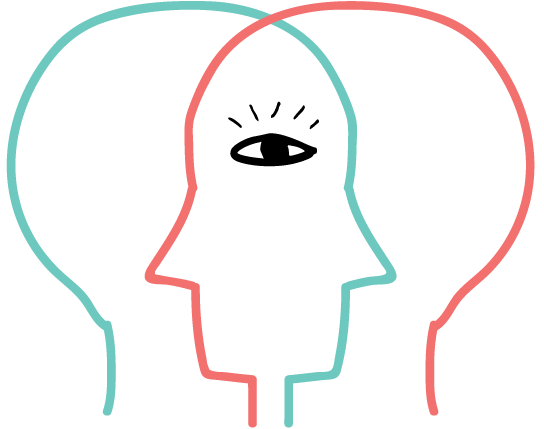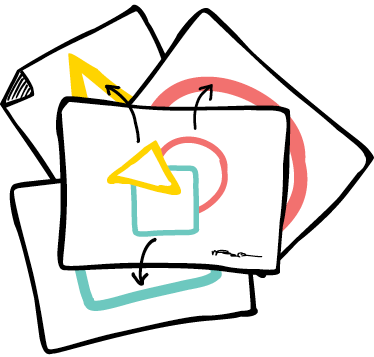While these methods are highly effective in capturing details, they risk losing the key message to TL;DR Syndrome: Too Long; Didn’t Read. In contrast, the audience can easily consume a well-constructed picture and use it as a springboard for driving to additional detail.
While there is undeniably a need for text-heavy documents in the business world, going back to our kindergarten roots and picking up the proverbial crayon (or its grown-up equivalent, the dry-erase marker) to draw a picture is a highly effective tool in communicating critical messages, stimulating discussions, and aligning stakeholders.
Let’s identify when a picture is most useful, how to get started, and what to do with your picture once it’s complete.
What Should I Draw?
You’ve got a blank piece of paper and crayon in hand—but what should you draw? Let’s consider some situations where drawing a picture can be helpful. Some examples come to mind immediately in the context of a project, including:



When Should I Start?
Do you ever find yourself in an unproductive meeting with several attendees approaching a topic from different perspectives, unable to see eye to eye? That’s a perfect time to draw a picture.
Visuals allow each attendee to look at the same concept at the same time, focus on the area of their choice, and see it in the context of someone else’s perspective. This feature is particularly helpful when broad communication is required. Participants can pass the crayon back and forth until they’ve come to a shared image they can move forward with.
Don’t wait until it’s too late: Pictures are often created when words fail, typically after many (and sometimes painful) attempts. While the English language is easily understood on the surface, it’s often imprecise. People can interpret the same sentence differently based on their expertise, interests, or past experiences. As George Bernard Shaw said, “The biggest problem with communication is the illusion that it has been accomplished.” Often, shared understanding documented in emails (or worse, agreed upon orally) can erode quickly. If you are thinking, “wait, wasn’t everyone in that same meeting?” then it’s time to eliminate the confusion by putting crayon to paper and starting to draw.
Many of these challenges can be alleviated with a proactive approach by helping teams to avoid diving into details too early. It forces teams to focus on visual concepts before the verbal or textual details, which can even shorten meetings since the team spends less time trying to describe the situation and can get on the same page more quickly.

Visuals allow each attendee to look at the same concept at the same 
How do I get Started?
Now that we’ve identified situations where a picture may be helpful, it’s simply a matter of bringing crayons and blank paper to a meeting of the minds—or is it?
In some cases, this approach may be appropriate, such as the early planning stages of a project or brainstorming departmental strategy. In those cases, a small group of leaders will set the direction for a larger group. When planning your work session where you will create a visual from scratch, you’ll want to allow plenty of time and establish a collaborative atmosphere.
Additionally, setting some basic ground rules and gaining commitment from all participants will help ensure the session is productive. Ground rules might include “one person speaks at a time,” “no bad ideas,” “everyone participates (draws),” etc.
If a group brainstorm isn’t right for your situation—and often, the number of participants, the level of the audience, or the stage of the project may rule it out—just start drawing!
This approach is called “acceleration.” The meaning is simple: Draw something to start from. It doesn’t need to be elegant. It doesn’t need to be exactly right. The idea is to improve the chance of a successful collaboration by creating enough of a picture to start a dialogue. In fact, doing too much before getting a group together increases the likelihood of wasted effort and low participation.
Don’t get stuck thinking you’re right, from the start. Be open to input and changes. It’s OK to be wrong. In fact, it won’t be right if you’re the only one who has worked on it. The benefit of this approach is that other people have something that they can react to and work from. An accelerated visual can immediately start a discussion of substance and build momentum.
Next, show it off. Once you’ve accelerated a visual, it’s time to walk it around. Allowing your team and other affected stakeholders to provide their input early is a very effective means to gain buy-in. Give them a crayon of their own so they can provide their feedback. You can share the first draft virtually, but an in-person conversation is best.
Every person tends to look at a picture through a different lens. After several reviews and updates, your picture will represent a collection of everyone’s thoughts and ideas. Think about it this way: If five people make changes to the picture, it has buy-in from five unique perspectives. The value of that picture has dramatically increased.
Continue to gather input from all relevant stakeholders to refine and finalize your picture. Although you are the facilitator of this masterpiece, the goal is not to sign your name in the bottom corner. The best pictures effectively have small signatures all over them.
The best pictures
best pictures
 effectively have
effectively have small
small signatures all
signatures all over.
over.

Leave your computer behind. Don’t rely on tools and technology to convey an idea. Shut down Excel and leave the computer behind. If crayons and paper are not stocked in your supply closet, find the nearest whiteboard.
Embrace the mess. Artists construct their works by layering paint on the canvas in stages to build depth and contrast. Similarly, your masterpiece will take shape as additional layers are added through revisions. The final version of your picture will likely look very different from the first draft, but it will benefit from the marks of the changes and input from all your collaborators along the way.
Consider creating more than one picture. You may require separate pictures to successfully tailor your message to different audiences. These pictures may even require different owners. For example, a large project schedule may have multiple layers:
Executive Level: One-slide, high-level schedule with key milestones.
Middle Tier: Program-level Visio file showing the key activities and dependencies across the project.
Detailed Level: Detailed project plan built in MS Project, owned by one person who is a project expert such as the project manager.
For early project phases, it may be helpful to start with a high-level picture to grasp the complexity of a project and use it to build a detailed plan. Conversely, if leadership is asking for an update on an in-flight effort, you can use the detailed plan to roll up the “need to know” information into an effective picture. A picture should be able to flex appropriately for each purpose.

Create supporting documents, there is only so much room on a piece of ![]()
What Should I do Next?
For one thing, don’t stop after the picture is complete, and has been approved by the right stakeholders. A picture is meant to visually depict and communicate an idea. While it’s commonly said that “a picture is worth a thousand words,” it is usually not intended to stand alone. As a summary of more granular details, it may require supporting materials.
For example, a high-level picture to represent project scope is a great way to ensure everyone agrees on what is (and is not) included in a project, but there is only so much room on a piece of paper. Create supporting documents, such as the project charter, to house all the details around the project’s scope at a more granular level.
Revisiting the picture is important to ensure it accurately reflects reality. One of the best things about a good picture is that it is typically hung on walls where it can be referenced often and used to communicate effectively.
Although it is an excellent communication tool, if it falls out of sync with reality, a picture can cause confusion. It’s best to manage an important picture like this centrally, on a team site, where everyone can see the latest version. It’s even a good idea to print out a new version regularly and tape it on top of the previous one if there have been changes.
This may seem obvious, but revisions are most important during periods of rapid change. One way to ensure pictures and documents are revisited is to add this review to the agenda of major project checkpoints.
The process of creating a good picture takes time. Remove any expectation that your drawing will be finished overnight. After all, you want it to be a masterpiece. It also takes time and practice to become a skilled artist. Look for opportunities to use your drawing skills and invite others to join the process. We all benefit by taking an artistic approach. Now leave your computer behind and go get some crayons.
